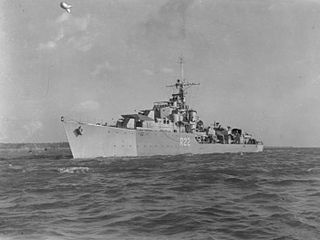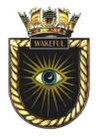
HMS Loch Fada was the lead ship of the Loch-class frigates of the British Royal Navy, built by John Brown & Company of Clydebank, Scotland, and named after Loch Fada in the Inner Hebrides.

The Battle class were a class of destroyers of the British Royal Navy (RN) and Royal Australian Navy (RAN), named after naval or other battles fought by British or English forces. Built in three groups, the first group were ordered under the 1942 naval estimates. A modified second and third group, together with two ships of an extended design were planned for the 1943 and 1944 estimates. Most of these ships were cancelled when it became apparent that the war was being won and the ships would not be required, although two ships of the third group, ordered for the RAN, were not cancelled and were subsequently completed in Australia.

HMCS Algonquin was a V-class destroyer, laid down for the Royal Navy as HMS Valentine (R17) and transferred to the Royal Canadian Navy on completion during the Second World War. She saw service in the Second World War escorting the aircraft carriers that bombed the Tirpitz in March 1944 and providing naval gunfire support to the Normandy landings. The destroyer was to participate in the Pacific Campaign but the war ended before her arrival in that theatre. Algonquin was converted in 1953 to a frigate and spent the majority of her remaining career in the Atlantic, being paid off in 1970.

HMS Battleaxe was a Weapon-class destroyer of the Royal Navy, completed just after the Second World War.

HMS Grenville was the second ship of this name to serve with the Royal Navy in the Second World War. Grenville and seven other U-class destroyers were ordered as part of the Emergency Programme. She was launched at Swan Hunter and Wigham Richardson Ltd., Wallsend-on-Tyne on 12 October 1942 and commissioned on 27 May 1943.

HMS Roebuck was an R-class destroyer of the British Royal Navy that saw service during World War II. She was the fifteenth ship to carry this traditional ship name, after a small deer native to the British Isles, which was used as far back as the reign of Queen Elizabeth I.

HMS Troubridge was a T-class destroyer of the British Royal Navy that saw service during the Second World War. Post war she was converted into a Type 15 frigate.

HMS Undaunted was a U-class destroyer of the British Royal Navy that saw service during World War II. She was later converted into a Type 15 fast anti-submarine frigate, with the new pennant number F53.

HMS Ursa was a U-class destroyer of the Royal Navy that saw service during the Second World War. She was later converted into a Type 15 fast anti-submarine frigate, with the new pennant number F200.

HMS Wizard was a W-class destroyer of the British Royal Navy that saw service during World War II.

HMS Apollo was an Abdiel-class minelayer of the Royal Navy, the eighth RN ship to carry the name. She served with the Home Fleet during World War II, taking part in the Normandy Landings before being transferred to the British Pacific Fleet. Put into reserve in 1946, she was recommissioned in 1951, serving until 1961, and was sold for scrapping in 1962.

HMS Carysfort was a C-class destroyer of the Royal Navy. She was ordered in 1941, originally under the name HMS Pique.

The fourth HMS Spragge (K572) and third ship of the name to enter service was a British Captain-class frigate of the Royal Navy in commission during World War II. Originally constructed as a United States Navy Buckley-class destroyer escort, she served in the Royal Navy from 1944 to 1946.

HMS Vivacious (D36) was a V-class destroyer of the British Royal Navy that saw service in World War I and World War II.

HMS Vanquisher (D54) was a V-class destroyer of the British Royal Navy that saw service in World War I and World War II.

The third HMS Windsor (D42) was a W-class destroyer of the British Royal Navy that saw service in the final months of World War I and in World War II.

The second HMS Wivern, was a Modified W-class destroyer of the British Royal Navy that saw service in World War II.

The eighth HMS Worcester, was a Modified W-class destroyer of the British Royal Navy that saw service in World War II. She later served as an accommodation ship as the second HMS Yeoman.

HMS Obedient was an O-class destroyer of the Royal Navy. She was built by William Denny and Brothers of Dumbarton, between 1940 and 1942. During Warship Week in 1942 she was adopted by the civil community of Lymington, United Kingdom. She was scrapped in 1962.




















